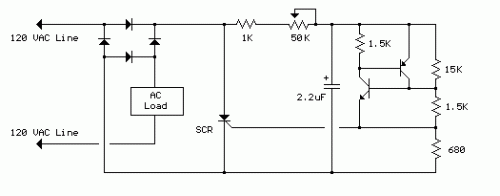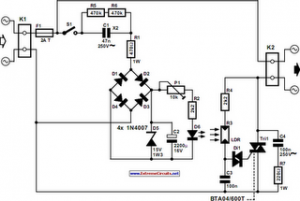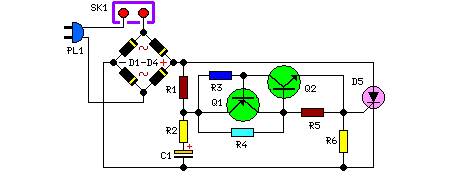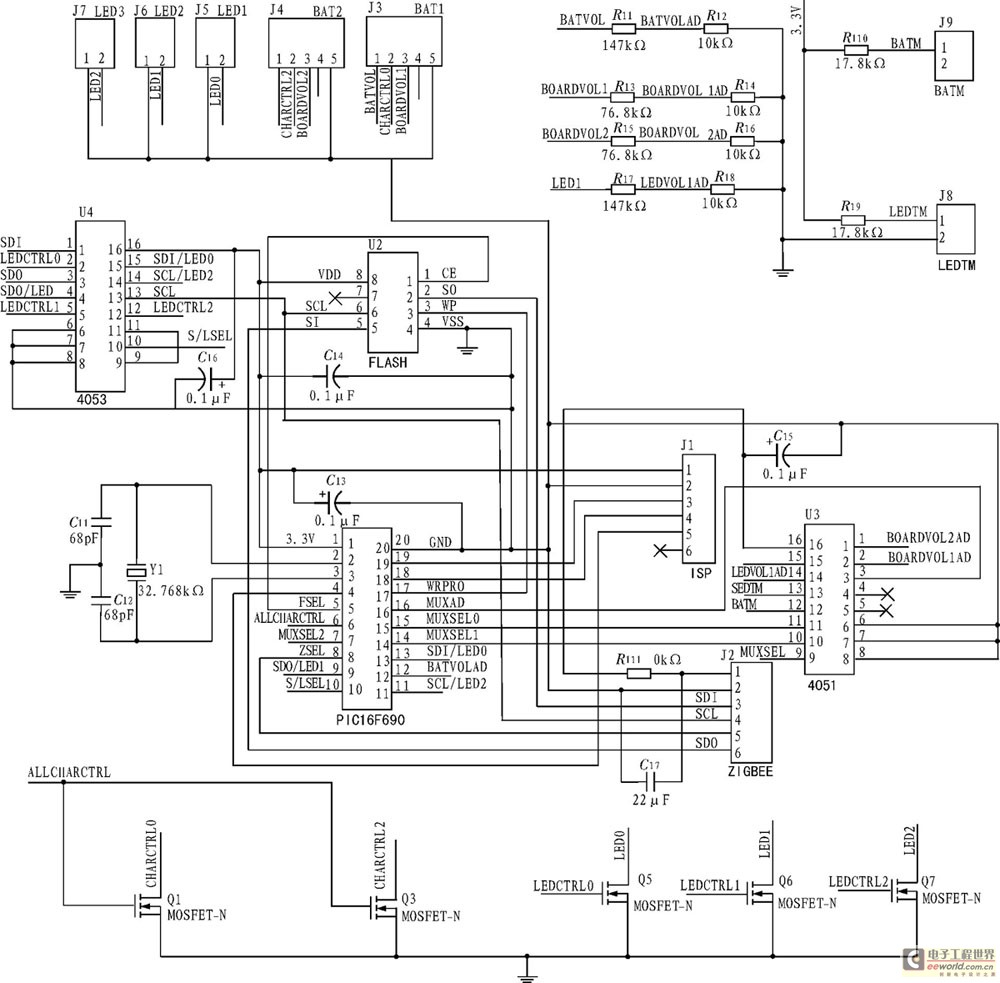
120 VAC Lamp Dimmer

The full-wave phase control circuit described was sourced from an RCA power circuits book published in 1969. In this configuration, the load is connected in series with the AC line, while four diodes are utilized to provide a full-wave rectified voltage to the anode of a Silicon Controlled Rectifier (SCR). Additionally, two small signal transistors are arranged in a switching configuration. When the voltage across the 2.2 µF capacitor reaches approximately 8 volts, these transistors activate, discharging the capacitor through the gate of the SCR and initiating its conduction.
This circuit operates by utilizing the principles of phase control to regulate power delivery to the load. The four diodes are arranged in a bridge rectifier configuration, ensuring that the AC input voltage is converted into a pulsating DC voltage. This rectified voltage is applied to the anode of the SCR, which is a semiconductor device capable of controlling large amounts of power.
The role of the 2.2 µF capacitor is critical in this design. It serves to smooth out the voltage fluctuations and acts as a timing element for the circuit. The small signal transistors, typically NPN types, are configured in such a way that they act as a switch. When the voltage across the capacitor reaches the threshold of 8 volts, the transistors turn on, creating a path for the capacitor to discharge. This discharge occurs through the gate of the SCR, triggering it into the conducting state.
Once the SCR is triggered, it remains in the 'on' state until the current flowing through it drops below a certain level, known as the holding current. This allows the SCR to control the power delivered to the load effectively. The phase control aspect enables the adjustment of the conduction angle of the SCR, which in turn regulates the amount of power supplied to the load.
Overall, this full-wave phase control circuit exemplifies an efficient method of controlling AC power using semiconductor devices, and its design principles remain applicable in various modern applications such as light dimmers, motor speed controllers, and heating elements.The full wave phase control circuit below was found in a RCA power circuits book from 1969. The load is placed in series with the AC line and the four diodes provide a full wave rectified voltage to the anode of a SCR. Two small signal transistors are connected in a switch configuration so that when the voltage on the 2.2uF capacitor reaches about 8 volts, the transistors will switch on and discharge the capacitor through the SCR gate causing it to begin conducting
🔗 External reference
This circuit operates by utilizing the principles of phase control to regulate power delivery to the load. The four diodes are arranged in a bridge rectifier configuration, ensuring that the AC input voltage is converted into a pulsating DC voltage. This rectified voltage is applied to the anode of the SCR, which is a semiconductor device capable of controlling large amounts of power.
The role of the 2.2 µF capacitor is critical in this design. It serves to smooth out the voltage fluctuations and acts as a timing element for the circuit. The small signal transistors, typically NPN types, are configured in such a way that they act as a switch. When the voltage across the capacitor reaches the threshold of 8 volts, the transistors turn on, creating a path for the capacitor to discharge. This discharge occurs through the gate of the SCR, triggering it into the conducting state.
Once the SCR is triggered, it remains in the 'on' state until the current flowing through it drops below a certain level, known as the holding current. This allows the SCR to control the power delivered to the load effectively. The phase control aspect enables the adjustment of the conduction angle of the SCR, which in turn regulates the amount of power supplied to the load.
Overall, this full-wave phase control circuit exemplifies an efficient method of controlling AC power using semiconductor devices, and its design principles remain applicable in various modern applications such as light dimmers, motor speed controllers, and heating elements.The full wave phase control circuit below was found in a RCA power circuits book from 1969. The load is placed in series with the AC line and the four diodes provide a full wave rectified voltage to the anode of a SCR. Two small signal transistors are connected in a switch configuration so that when the voltage on the 2.2uF capacitor reaches about 8 volts, the transistors will switch on and discharge the capacitor through the SCR gate causing it to begin conducting
🔗 External reference





